Harish Ravichandar
JaxRobotarium: Training and Deploying Multi-Robot Policies in 10 Minutes
May 10, 2025Abstract:Multi-agent reinforcement learning (MARL) has emerged as a promising solution for learning complex and scalable coordination behaviors in multi-robot systems. However, established MARL platforms (e.g., SMAC and MPE) lack robotics relevance and hardware deployment, leaving multi-robot learning researchers to develop bespoke environments and hardware testbeds dedicated to the development and evaluation of their individual contributions. The Multi-Agent RL Benchmark and Learning Environment for the Robotarium (MARBLER) is an exciting recent step in providing a standardized robotics-relevant platform for MARL, by bridging the Robotarium testbed with existing MARL software infrastructure. However, MARBLER lacks support for parallelization and GPU/TPU execution, making the platform prohibitively slow compared to modern MARL environments and hindering adoption. We contribute JaxRobotarium, a Jax-powered end-to-end simulation, learning, deployment, and benchmarking platform for the Robotarium. JaxRobotarium enables rapid training and deployment of multi-robot reinforcement learning (MRRL) policies with realistic robot dynamics and safety constraints, supporting both parallelization and hardware acceleration. Our generalizable learning interface provides an easy-to-use integration with SOTA MARL libraries (e.g., JaxMARL). In addition, JaxRobotarium includes eight standardized coordination scenarios, including four novel scenarios that bring established MARL benchmark tasks (e.g., RWARE and Level-Based Foraging) to a realistic robotics setting. We demonstrate that JaxRobotarium retains high simulation fidelity while achieving dramatic speedups over baseline (20x in training and 150x in simulation), and provides an open-access sim-to-real evaluation pipeline through the Robotarium testbed, accelerating and democratizing access to multi-robot learning research and evaluation.
Learning Flexible Heterogeneous Coordination with Capability-Aware Shared Hypernetworks
Jan 10, 2025Abstract:Cooperative heterogeneous multi-agent tasks require agents to effectively coordinate their behaviors while accounting for their relative capabilities. Learning-based solutions to this challenge span between two extremes: i) shared-parameter methods, which encode diverse behaviors within a single architecture by assigning an ID to each agent, and are sample-efficient but result in limited behavioral diversity; ii) independent methods, which learn a separate policy for each agent, and show greater behavioral diversity but lack sample-efficiency. Prior work has also explored selective parameter-sharing, allowing for a compromise between diversity and efficiency. None of these approaches, however, effectively generalize to unseen agents or teams. We present Capability-Aware Shared Hypernetworks (CASH), a novel architecture for heterogeneous multi-agent coordination that generates sufficient diversity while maintaining sample-efficiency via soft parameter-sharing hypernetworks. Intuitively, CASH allows the team to learn common strategies using a shared encoder, which are then adapted according to the team's individual and collective capabilities with a hypernetwork, allowing for zero-shot generalization to unseen teams and agents. We present experiments across two heterogeneous coordination tasks and three standard learning paradigms (imitation learning, on- and off-policy reinforcement learning). CASH is able to outperform baseline architectures in success rate and sample efficiency when evaluated on unseen teams and agents despite using less than half of the learnable parameters.
On the Surprising Effectiveness of Spectrum Clipping in Learning Stable Linear Dynamics
Dec 03, 2024



Abstract:When learning stable linear dynamical systems from data, three important properties are desirable: i) predictive accuracy, ii) provable stability, and iii) computational efficiency. Unconstrained minimization of reconstruction errors leads to high accuracy and efficiency but cannot guarantee stability. Existing methods to remedy this focus on enforcing stability while also ensuring accuracy, but do so only at the cost of increased computation. In this work, we investigate if a straightforward approach can simultaneously offer all three desiderata of learning stable linear systems. Specifically, we consider a post-hoc approach that manipulates the spectrum of the learned system matrix after it is learned in an unconstrained fashion. We call this approach spectrum clipping (SC) as it involves eigen decomposition and subsequent reconstruction of the system matrix after clipping all of its eigenvalues that are larger than one to one (without altering the eigenvectors). Through detailed experiments involving two different applications and publicly available benchmark datasets, we demonstrate that this simple technique can simultaneously learn highly accurate linear systems that are provably stable. Notably, we demonstrate that SC can achieve similar or better performance than strong baselines while being orders-of-magnitude faster. We also show that SC can be readily combined with Koopman operators to learn stable nonlinear dynamics, such as those underlying complex dexterous manipulation skills involving multi-fingered robotic hands. Our codes and dataset can be found at https://github.com/GT-STAR-Lab/spec_clip.
AsymDex: Leveraging Asymmetry and Relative Motion in Learning Bimanual Dexterity
Nov 20, 2024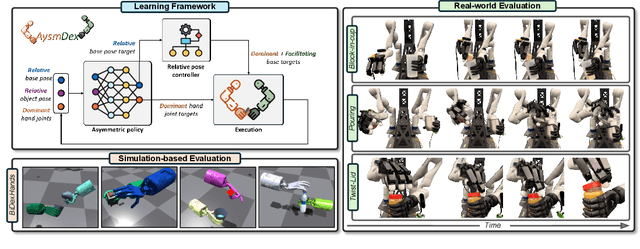



Abstract:We present Asymmetric Dexterity (AsymDex), a novel reinforcement learning (RL) framework that can efficiently learn asymmetric bimanual skills for multi-fingered hands without relying on demonstrations, which can be cumbersome to collect. Two crucial ingredients enable AsymDex to reduce the observation and action space dimensions and improve sample efficiency. First, AsymDex leverages the natural asymmetry found in human bimanual manipulation and assigns specific and interdependent roles to each hand: a facilitating hand that moves and reorients the object, and a dominant hand that performs complex manipulations on said object. Second, AsymDex defines and operates over relative observation and action spaces, facilitating responsive coordination between the two hands. Further, AsymDex can be easily integrated with recent advances in grasp learning to handle both the object acquisition phase and the interaction phase of bimanual dexterity. Unlike existing RL-based methods for bimanual dexterity, which are tailored to a specific task, AsymDex can be used to learn a wide variety of bimanual tasks that exhibit asymmetry. Detailed experiments on four simulated asymmetric bimanual dexterous manipulation tasks reveal that AsymDex consistently outperforms strong baselines that challenge its design choices, in terms of success rate and sample efficiency. The project website is at https://sites.google.com/view/asymdex-2024/.
KOROL: Learning Visualizable Object Feature with Koopman Operator Rollout for Manipulation
Jun 29, 2024Abstract:Learning dexterous manipulation skills presents significant challenges due to complex nonlinear dynamics that underlie the interactions between objects and multi-fingered hands. Koopman operators have emerged as a robust method for modeling such nonlinear dynamics within a linear framework. However, current methods rely on runtime access to ground-truth (GT) object states, making them unsuitable for vision-based practical applications. Unlike image-to-action policies that implicitly learn visual features for control, we use a dynamics model, specifically the Koopman operator, to learn visually interpretable object features critical for robotic manipulation within a scene. We construct a Koopman operator using object features predicted by a feature extractor and utilize it to auto-regressively advance system states. We train the feature extractor to embed scene information into object features, thereby enabling the accurate propagation of robot trajectories. We evaluate our approach on simulated and real-world robot tasks, with results showing that it outperformed the model-based imitation learning NDP by 1.08$\times$ and the image-to-action Diffusion Policy by 1.16$\times$. The results suggest that our method maintains task success rates with learned features and extends applicability to real-world manipulation without GT object states.
Learning Prehensile Dexterity by Imitating and Emulating State-only Observations
Apr 12, 2024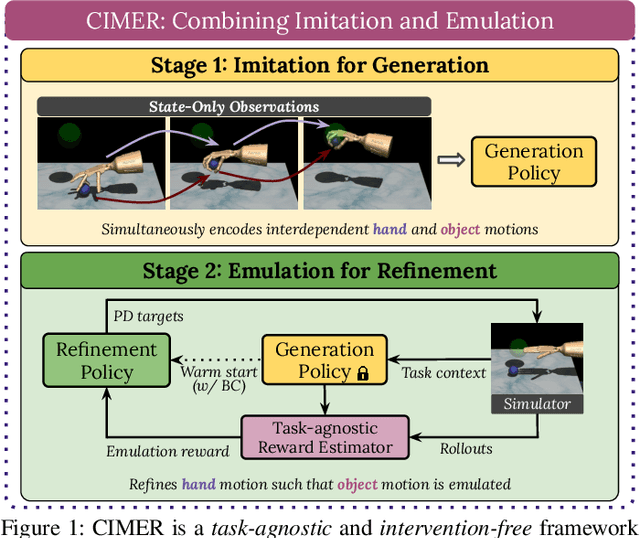
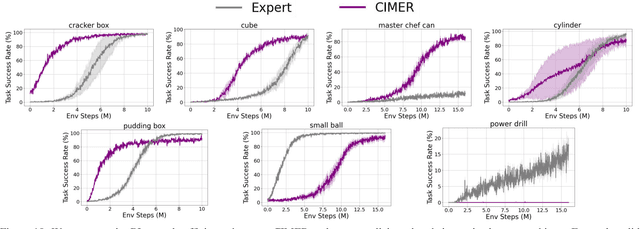
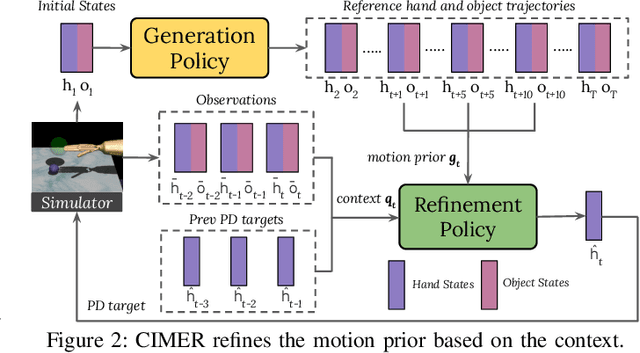

Abstract:When human acquire physical skills (e.g., tennis) from experts, we tend to first learn from merely observing the expert. But this is often insufficient. We then engage in practice, where we try to emulate the expert and ensure that our actions produce similar effects on our environment. Inspired by this observation, we introduce Combining IMitation and Emulation for Motion Refinement (CIMER) -- a two-stage framework to learn dexterous prehensile manipulation skills from state-only observations. CIMER's first stage involves imitation: simultaneously encode the complex interdependent motions of the robot hand and the object in a structured dynamical system. This results in a reactive motion generation policy that provides a reasonable motion prior, but lacks the ability to reason about contact effects due to the lack of action labels. The second stage involves emulation: learn a motion refinement policy via reinforcement that adjusts the robot hand's motion prior such that the desired object motion is reenacted. CIMER is both task-agnostic (no task-specific reward design or shaping) and intervention-free (no additional teleoperated or labeled demonstrations). Detailed experiments with prehensile dexterity reveal that i) imitation alone is insufficient, but adding emulation drastically improves performance, ii) CIMER outperforms existing methods in terms of sample efficiency and the ability to generate realistic and stable motions, iii) CIMER can either zero-shot generalize or learn to adapt to novel objects from the YCB dataset, even outperforming expert policies trained with action labels in most cases. Source code and videos are available at https://sites.google.com/view/cimer-2024/.
Generalization of Heterogeneous Multi-Robot Policies via Awareness and Communication of Capabilities
Jan 23, 2024Abstract:Recent advances in multi-agent reinforcement learning (MARL) are enabling impressive coordination in heterogeneous multi-robot teams. However, existing approaches often overlook the challenge of generalizing learned policies to teams of new compositions, sizes, and robots. While such generalization might not be important in teams of virtual agents that can retrain policies on-demand, it is pivotal in multi-robot systems that are deployed in the real-world and must readily adapt to inevitable changes. As such, multi-robot policies must remain robust to team changes -- an ability we call adaptive teaming. In this work, we investigate if awareness and communication of robot capabilities can provide such generalization by conducting detailed experiments involving an established multi-robot test bed. We demonstrate that shared decentralized policies, that enable robots to be both aware of and communicate their capabilities, can achieve adaptive teaming by implicitly capturing the fundamental relationship between collective capabilities and effective coordination. Videos of trained policies can be viewed at: https://sites.google.com/view/cap-comm
The Effects of Robot Motion on Comfort Dynamics of Novice Users in Close-Proximity Human-Robot Interaction
Aug 02, 2023Abstract:Effective and fluent close-proximity human-robot interaction requires understanding how humans get habituated to robots and how robot motion affects human comfort. While prior work has identified humans' preferences over robot motion characteristics and studied their influence on comfort, we are yet to understand how novice first-time robot users get habituated to robots and how robot motion impacts the dynamics of comfort over repeated interactions. To take the first step towards such understanding, we carry out a user study to investigate the connections between robot motion and user comfort and habituation. Specifically, we study the influence of workspace overlap, end-effector speed, and robot motion legibility on overall comfort and its evolution over repeated interactions. Our analyses reveal that workspace overlap, in contrast to speed and legibility, has a significant impact on users' perceived comfort and habituation. In particular, lower workspace overlap leads to users reporting significantly higher overall comfort, lower variations in comfort, and fewer fluctuations in comfort levels during habituation.
MARBLER: An Open Platform for Standarized Evaluation of Multi-Robot Reinforcement Learning Algorithms
Jul 15, 2023Abstract:Multi-agent reinforcement learning (MARL) has enjoyed significant recent progress, thanks to deep learning. This is naturally starting to benefit multi-robot systems (MRS) in the form of multi-robot RL (MRRL). However, existing infrastructure to train and evaluate policies predominantly focus on challenges in coordinating virtual agents, and ignore characteristics important to robotic systems. Few platforms support realistic robot dynamics, and fewer still can evaluate Sim2Real performance of learned behavior. To address these issues, we contribute MARBLER: Multi-Agent RL Benchmark and Learning Environment for the Robotarium. MARBLER offers a robust and comprehensive evaluation platform for MRRL by marrying Georgia Tech's Robotarium (which enables rapid prototyping on physical MRS) and OpenAI's Gym framework (which facilitates standardized use of modern learning algorithms). MARBLER offers a highly controllable environment with realistic dynamics, including barrier certificate-based obstacle avoidance. It allows anyone across the world to train and deploy MRRL algorithms on a physical testbed with reproducibility. Further, we introduce five novel scenarios inspired by common challenges in MRS and provide support for new custom scenarios. Finally, we use MARBLER to evaluate popular MARL algorithms and provide insights into their suitability for MRRL. In summary, MARBLER can be a valuable tool to the MRS research community by facilitating comprehensive and standardized evaluation of learning algorithms on realistic simulations and physical hardware. Links to our open-source framework and the videos of real-world experiments can be found at https://shubhlohiya.github.io/MARBLER/.
Concurrent Constrained Optimization of Unknown Rewards for Multi-Robot Task Allocation
May 24, 2023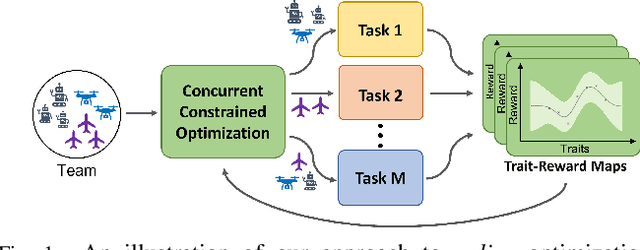
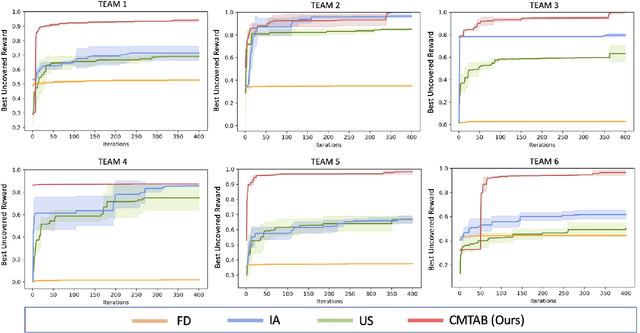
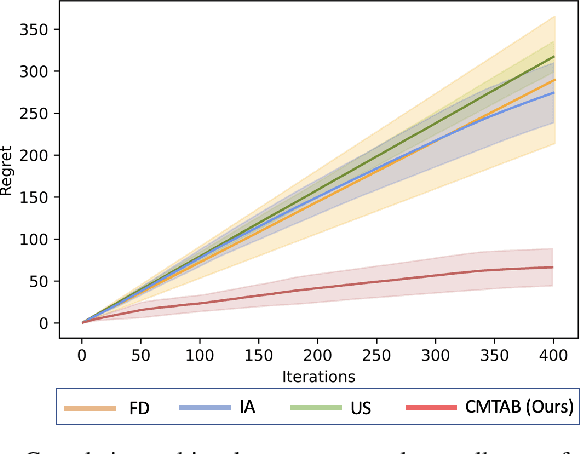
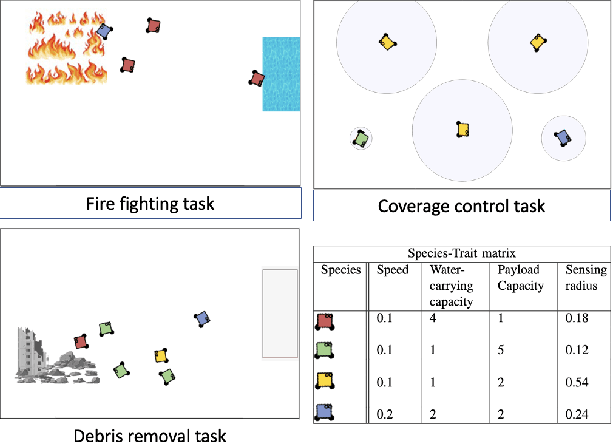
Abstract:Task allocation can enable effective coordination of multi-robot teams to accomplish tasks that are intractable for individual robots. However, existing approaches to task allocation often assume that task requirements or reward functions are known and explicitly specified by the user. In this work, we consider the challenge of forming effective coalitions for a given heterogeneous multi-robot team when task reward functions are unknown. To this end, we first formulate a new class of problems, dubbed COncurrent Constrained Online optimization of Allocation (COCOA). The COCOA problem requires online optimization of coalitions such that the unknown rewards of all the tasks are simultaneously maximized using a given multi-robot team with constrained resources. To address the COCOA problem, we introduce an online optimization algorithm, named Concurrent Multi-Task Adaptive Bandits (CMTAB), that leverages and builds upon continuum-armed bandit algorithms. Experiments involving detailed numerical simulations and a simulated emergency response task reveal that CMTAB can effectively trade-off exploration and exploitation to simultaneously and efficiently optimize the unknown task rewards while respecting the team's resource constraints.
 Add to Chrome
Add to Chrome Add to Firefox
Add to Firefox Add to Edge
Add to Edge